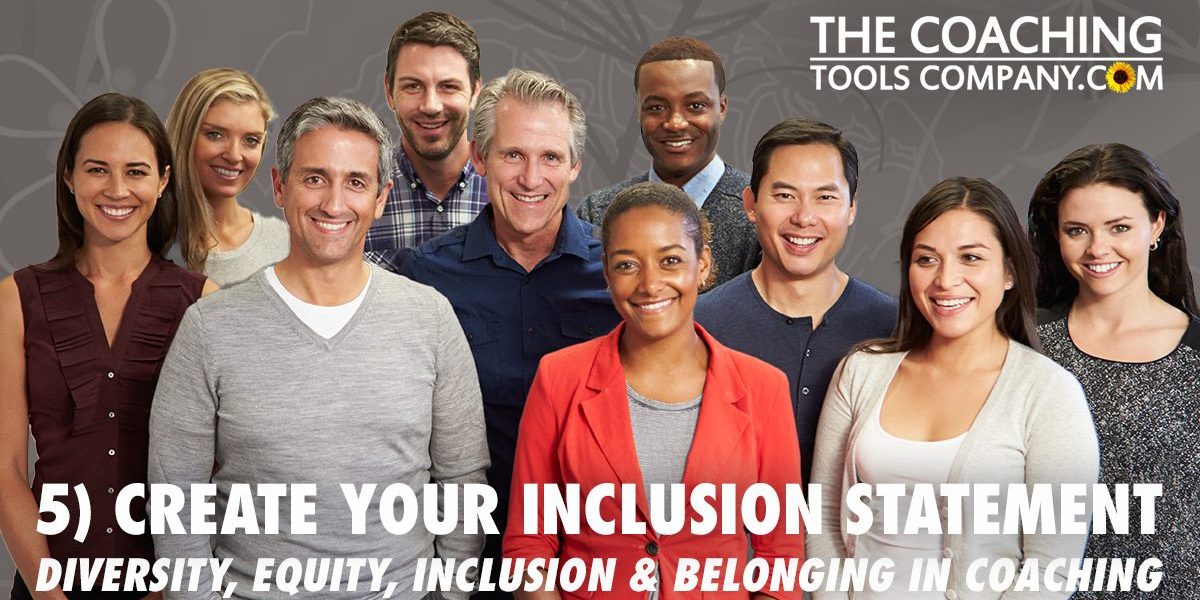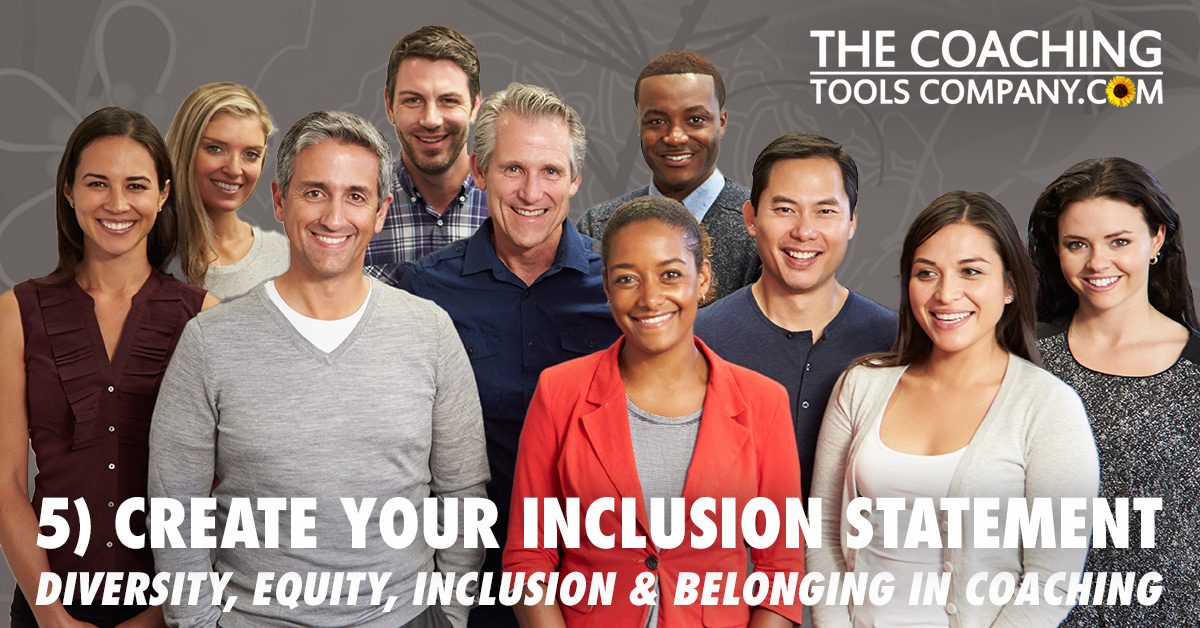Originally Posted on The Coaching Tools Company as DEIB in Coaching 5) Create Your Inclusion Statement | Abena Baiden & Emma-Louise (Free .PDF Tool)
Diversity is a fact. Equity is a choice. Inclusion is an action. Belonging is an outcome. Arthur Chan, Diversity, Equity, and Inclusion Strategist
We’re excited you’re here!
If you’re reading this, you’re most likely looking for ideas or wondering how coaching can be more inclusive. Yes, this topic of Diversity, Equity, Inclusion and Belonging (DEIB) can be intimidating or uncomfortable, but the more we normalise it—and approach it and ourselves with empathy—the easier it will become. Whether you agree or disagree with the points made in this article, it is our hope that reading it promotes awareness and, of course, action!
This article is part of a series where we’ve suggested 7 Ways You Can Increase (Your) Cultural Awareness in Your Coaching Practice. Here we explore Step 5) Create Your Inclusion Statement.
And if you haven’t already done so, we recommend you read DEIB in Coaching 1) Identity Mapping Exercises: The Identity Iceberg (Free .PDF Tool) and complete your Iceberg Identity Map before reading on. This will both help you craft your inclusion statement in an authentic fashion, and you also get to join us on this thinking journey and really embrace the ‘why’ behind it all.
What’s in this ArticleIn this article we explore:
|
So, what is an inclusion statement?
An inclusion statement is simply a public statement that expresses your commitment to diversity, equity and inclusion.
This statement communicates that, for you, Diversity, Equity, Inclusion and Belonging (DEIB)* is not just encouraged but being actively pursued. And the inclusion statement outlines the values, beliefs, and behaviours that the organization or individual will uphold.
The aim of an inclusion statement is to explicitly create an environment that is welcoming, affirming and inclusive for all individuals—especially those from historically underrepresented or marginalised groups.
This statement may also outline any tangible actions the writer is taking to honour this commitment, such as priority focus or additional resources for minority groups.
For a coach, your statement can ‘call in’ those who might otherwise feel that your services do not invite or include them. If you’d like to see an example before reading on, see below or take a look at Abena’s inclusion statement here, and Emma-Louise’s inclusion statement at Fierce Kindness here.
Example inclusion statementYour inclusion statement doesn’t need to be long, the important thing is that you have one. Below we share a simple inclusion statement that we love. Source: Shared in an article on belongingness by Montrece McNeill Ransom‘s and found on a sign that hangs in Evanston Township High School in Evanston, Illinois, This focuses on students: “You are a member of a school where we not only respect differences, we embrace our diversity. We embrace one another’s race and ethnicity. We embrace one another’s family background, heritage, language, culture. We embrace one another’s religion and your right to your own personal customs and beliefs. We embrace your sexual orientation and your gender identity. We embrace your special needs. We embrace you… And value you as individual human beings. Never forget: You belong here in the school—each and every one of you.” |
Why this matters
We all want to work and play in spaces where our identities and experiences are respected and valued.
So when we explicitly state a commitment to DEIB (Diversity, Equity, Inclusion and Belonging)*, we’re telling potential clients that they’re welcome and encouraged to work with us: they are ‘seen’.
This can help convince those from more diverse groups that coaching really is for everyone. And that you could be the coach for them…
And for coaches, embracing DEIB—and clients who are different to us—enriches the coaching experience itself by bringing a wide range of perspectives and stories into the conversation.
So, inclusion in coaching not only supports individual growth and empowerment (for both the coach and client) but also contributes to a broader cultural shift towards equity, understanding, and perhaps most importantly: belonging.
As Montrece McNeill Ransom points out in her article on belongingness in the workplace:
Belongingness must be about giving those who have traditionally been on the sidelines their time in the sun and a chance to maximize their inherent human potential and capacities for the collective good.
What we love about this quote is how it captures the essence of coaching in terms of maximising “human potential and capacities”. Isn’t that just the perfect description of what coaches do?
| * We chose to use DEIB as the consistent term we use throughout this article series. There are others like DEIJ and DEIA and DEIAJ where the J stands for Justice, or A where the a stands for Accessibilty. We were inspired to use the B by Montrece McNeill Ransom’s article on belonging here.
As you learn and grow you may find you prefer to use a different acronym that speaks to you. |
How do we create an authentic inclusion statement?
Creating an inclusion statement begins with understanding.
So, if you haven’t already, educate yourself on the challenges faced by different minority groups. The language that best respects and acknowledges these experiences will come from their own words, so take some time to learn and educate yourself and/or engage with these communities online or in-person.
But, don’t let your fear of getting it wrong get in the way! First, even writing an inclusion statement is a big step forward. And second, your inclusion statement is not a one-time thing: you will likely change it as you learn and grow. In fact Abena tweaked hers while working on this article!
So, your inclusion statement doesn’t need to be perfect—it can (and perhaps should) be a work in progress!
Yes, creating an authentic inclusion statement should be done thoughtfully and with introspection.
But you don’t have to understand everything about DEIB—what matters is your commitment to personal learning and growth.
What matters is that you’ve educated yourself, reflected and then made the effort to create and share your inclusion statement.
So here’s how to create your authentic inclusion statement:
Follow these steps:
- Step1) Reflect on your own journey. Acknowledge your privileges, biases, and the areas where you need to grow. (We all have them!).
- Tip: You may also find it useful to review your completed Identity Iceberg Exercise.
- Step 2) Draft your inclusion statement.
- Use the Create Your Inclusion Statement Tool here to explore and create your Inclusion Statement!
- Step 3) Review your inclusion statement. Consult with a DEIB expert or member/s of the groups you wish to support. This ensures your inclusion statement is not only well-intentioned but also informed and effective.
- Step 4) Update your statement following any feedback.
- Remember to also update your inclusion statement as you evolve. This reflects your ongoing learning and commitment to DEIB.
- Step 5) Add your inclusion statement to your website and any marketing or employment materials as needed.
Get your FREE Create Your Inclusion Statement Exercise here: Click to download your FREE
Click to download your FREE
Inclusion Statement Exercise (.PDF) >>
Please note: this exercise is not brandable as it is not client-facing.
Where can we share our inclusion statement?
We should aim to display our inclusion statement in places where it will be seen and read by current and prospective clients and potential employees or contractors. This might include:
- Displaying or linking to it on your website ‘Home’ and/or ‘About’ page.
- Include a link (or use a QR code) in your promotional materials.
- On your recruitment materials if you employ others (such as a virtual assistant or social media manager).
- Adding it to your social media profiles as part of your bio.
- Adding in onto regular or relevant posts to reinforce your commitment to DEIB.
Finally, go beyond words
To make your inclusion statement truly authentic, consider what you will DO differently in your coaching practice.
What specific, actionable steps you will take to make your coaching practice more inclusive and supportive?
And of course, consider mentioning these action steps in or to support your inclusion statement.
Wrap Up
We hope this article inspired you to craft your inclusion statement!
And remember that it also benefits you as you get to:
- Expand the scope of who you attract and help.
- Live into your DEI values.
- Show the world a broader picture of who you are and what you stand for, both role modelling what is possible and boosting your business “brand”.
Remember, you don’t have to be an expert—just a willing learner with an open heart and mind.
And now it’s over to you!
So, what do you think? What did you learn from this article? And importantly, what will you do differently?
Remember that if you decide to start ‘diversity’ conversations with fellow coaches in person or in online spaces, you are contributing to greater awareness and a more inclusive coaching industry.
Now watch for the next in this series of 7 articles!
Where Next?
- The next article is about making (some of) your services accessible to those with fewer financial resources.
- And if you didn’t already, you might like:
- Read the introductory: 7 Ways You Can Increase (Your) Cultural Awareness in Your Coaching Practice
- Read the story of how these articles came to be here >>
- The series of 7 articles:
- 1) Identity Mapping Exercises: The Identity Iceberg (Free .PDF Tool)
- 2) Review Your Marketing Materials (With Checklist)
- 3) Include Identity & Culture in Your Onboarding Process
- 4) Serve Marginalised Individuals/Groups
Lastly, whilst you won’t see a disclosure in every article on our blog, we think it’s important to do so when covering this DEIB topic:
| DISCLOSURE: This article has been written from the perspective of a female who is (largely) heteronormative and of White European descent and another atypical female who is of Ghanaian, Irish, and British descent. We acknowledge that even with both our perspectives and best intentions, we may (like everyone) have blind spots and are open to discussion about these. |
So what do you think? Tell us what we missed or what else should be on these lists! What did you take away from this article? Share your thoughts in the comments below!
Author Bios
Emma-Louise Elsey has been coaching since 2003. She’s the founder of both The Coaching Tools Company.com and her latest venture, Fierce Kindness where she shares personal tips, tools and ideas to transform ourselves—and our world! Originally a project/relationship manager for Fortune 500 companies she’s combined her passion for coaching, creativity and love of systems to create 100+ brandable coaching exercises including 30 completely free coaching tools. She serves coaches through her newsletter for coaches and loves to offer ideas for your coaching toolbox! Learn more about Emma-Louise & see all their articles here >> |



 Contributing author:
Contributing author: 




